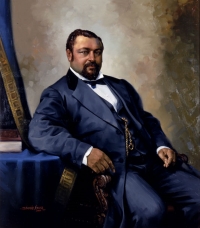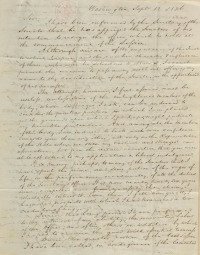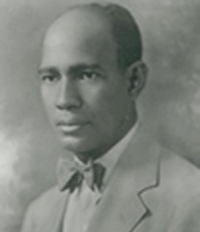To celebrate Black History Month, the Senate Historical Office presents stories, profiles, and interviews available on Senate.gov that recognize the many contributions of African Americans to the U.S. Senate and the integral role they have played in Senate history.

Shortly after the Civil War, Hiram R. Revels (1870) and Blanche K. Bruce (1875) of Mississippi set historic milestones as the first African Americans to be elected to the Senate. It would be nearly another century—not until 1967—before Edward W. Brooke of Massachusetts followed in their historic footsteps. In 1993 Carol Moseley Braun of Illinois became the first African American woman to be elected to the Senate. To date, 11 African Americans have served as U.S. senators. In 2021 California senator Kamala D. Harris resigned her Senate seat and took the oath of office as the nation’s 49th vice president, thereby becoming the first African American to serve as the president of the Senate.
The role of African Americans in Senate history extends beyond those who served in elected office. One of their earliest and most enduring contributions came with the construction of the U.S. Capitol. Although historians know little about the laborers who built the Capitol, evidence shows that much of that labor force was African American, both free and enslaved. Many years later, Philip Reid, an enslaved man, brought to the Capitol the mechanical expertise needed to separate and then cast the individual sections of the Statue of Freedom, which was placed atop the Capitol Dome in 1863.

African Americans also worked in and around the Senate Chamber in the 19th century. Tobias Simpson, for example, was a messenger from 1808 to 1825. His quick action during the British attack on the Capitol in 1814 saved valuable Senate records, and he was subsequently honored with a resolution (and a pay bonus). His role in that record-saving endeavor was described in an 1836 letter written by Senate clerk Lewis Machen. Another example was a young African American boy named William Hill. In the winter of 1820, senators counted on the warmth provided by fires tended by Hill, who was paid $37 for his services by Sergeant at Arms Mountjoy Bayly.
Several African Americans employed by the Senate became trailblazers. In 1868 Senate employee Kate Brown sued a railroad company that forcibly removed her from a train after she refused to sit in the car designated for Black passengers. Brown’s case eventually made it to the Supreme Court, which ruled in Brown’s favor in 1873. The first African American to join the Senate’s historic page program, Andrew F. Slade, was appointed in 1869 and served until 1881. John Sims, known by his contemporaries as the “Bishop of the Senate,” built relationships with senators in the late 19th and early 20th centuries as both a Senate barber and a popular Washington, D.C., preacher.

The first African Americans to be hired for professional clerical positions appeared in the early 20th century, including Robert Ogle, a messenger and clerk for the Senate Appropriations Committee, and Jesse Nichols, who served as government documents clerk for the Senate Finance Committee from 1937 to 1971. Senate staff members Thomas Thornton and Christine McCreary and news correspondent Louis Lautier challenged the de facto segregation of Capitol Hill in the 1940s, '50s and '60s. In 1985 Trudi Morrison became the first woman and the first African American to serve as deputy sergeant at arms of the Senate. Alfonso E. Lenhardt, who served as sergeant at arms from 2001 to 2003, was the first African American to hold that post. The Senate appointed Dr. Barry C. Black as Senate chaplain on July 7, 2003, another first for African Americans. On March 1, 2021, Sonceria Ann Berry became the first African American to serve as secretary of the Senate.
These are just a few milestones among many. As research continues, Senate historians are discovering other stories of African Americans who have played a unique and integral role in Senate history.